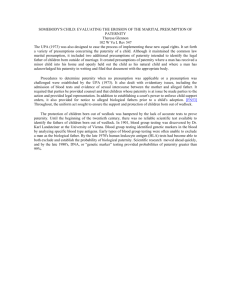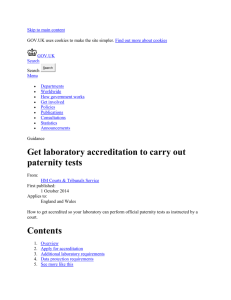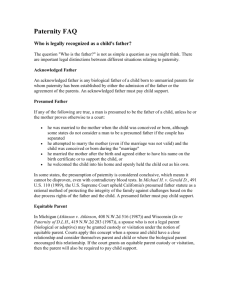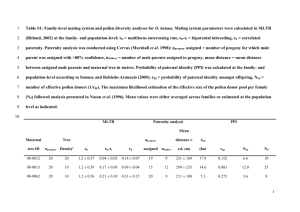Paternity: Beyond Biology - CHILD SUPPORT DIRECTORS ASSOCIATION of
advertisement
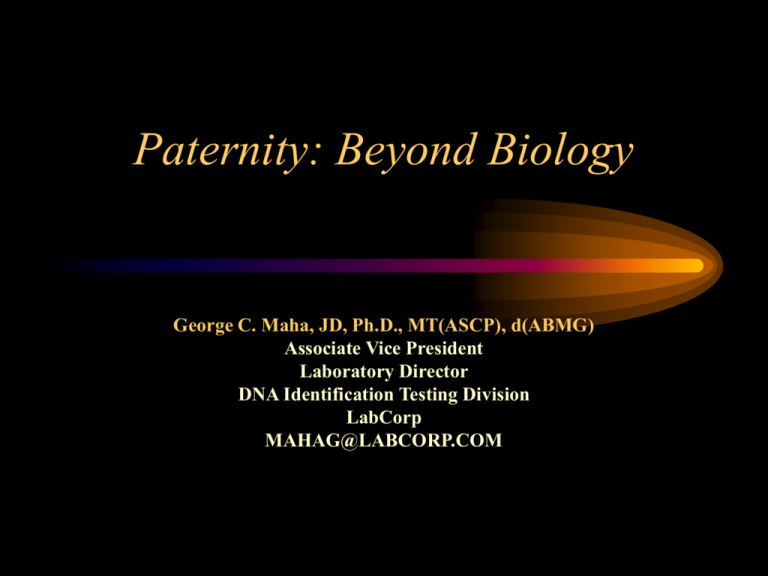
Paternity: Beyond Biology George C. Maha, JD, Ph.D., MT(ASCP), d(ABMG) Associate Vice President Laboratory Director DNA Identification Testing Division LabCorp MAHAG@LABCORP.COM Beyond Biology • Is knowing your biological relationship important? Beyond Biology • Is knowing your biological relationship important? • Should biology always trump? Beyond Biology • Is knowing your biological relationship important? • Should biology always trump? • What are the effects of other facts when determining biological relationships? Beyond Biology • Is knowing your biological relationship important? • Should biology always trump? • What are the effects of other facts when determining biological relationships? Is knowing your biological relationship important? • Medical • Psychological • Social Is knowing your biological relationship important? • Medical • Psychological – Child – Not just the child – Unexpected exclusion • Social Beyond Biology - Should biology always trump? • Michael H. v. Gerald D., 491 U.S. 110, 109 S.Ct. 2333 (1989) . Michael H. v. Gerald D., 491 U.S. 110, 109 S.Ct. 2333 (1989) . • Appellant Victoria D. was born to Carole D., who was married to, and resided with, appellee Gerald D. in California. Although Gerald was listed as father on the birth certificate and has always claimed Victoria as his daughter, blood tests showed that appellant Michael H., with whom Carole had had an adulterous affair, was Victoria's father. During Victoria's first three years, she and her mother resided at times with Michael, who held her out as his own, at times with another man, and at times with Gerald. Michael H. v. Gerald D., 491 U.S. 110, 109 S.Ct. 2333 (1989) . • Michael filed a filiation action in California Superior Court to establish his paternity and right to visitation. Victoria, through her court-appointed guardian ad litem, filed a cross-complaint asserting that she was entitled to maintain filial relationships with both Michael and Gerald. The court ultimately granted Gerald summary judgment on the ground that there were no triable issues of fact as to paternity under Cal. Evid. Code 621, which provides that a child born to a married woman living with her husband, who is neither impotent nor sterile, is presumed to be a child of the marriage, and that this presumption may be rebutted only by the husband or wife, and then only in limited circumstances. Michael H. v. Gerald D., 491 U.S. 110, 109 S.Ct. 2333 (1989) . • Moreover, the court denied Michael's and Victoria's motions for visitation pending appeal under Cal. Civ. Code 4601, which provides that a court may, in its discretion, grant "reasonable visitation rights . . . to any . . . person having an interest in the [child's] welfare." The California Court of Appeal affirmed, rejecting Michael's procedural and substantive due process challenges to 621 as well as Victoria's due process and equal protection claims. The court also rejected Victoria's assertion of a right to continued visitation with Michael under 4601, on the ground that California law denies visitation against the wishes of the mother to a putative father who has been prevented by 621 from establishing his paternity. Michael H. v. Gerald D., 491 U.S. 110, 109 S.Ct. 2333 (1989) . • Justice Scalia: The 621 presumption does not infringe upon the due process rights of a man wishing to establish his paternity of a child born to the wife of another man. Michael H. v. Gerald D., 491 U.S. 110, 109 S.Ct. 2333 (1989) . • Justice Scalia: The 621 presumption does not infringe upon any constitutional right of a child to maintain a relationship with her natural father. Victoria's assertion that she has a due process right to maintain filial relationships with both Michael and Gerald is, at best, the obverse of Michael's claim and fails for the same reasons. Nor is there any merit to her claim that her equal protection rights have been violated because, unlike her mother and presumed father, she had no opportunity to rebut the presumption of her legitimacy, since the State's decision to treat her differently from her parents pursues the legitimate end of preventing the disruption of an otherwise peaceful union by the rational means of not allowing anyone but the husband or wife to contest legitimacy Should biology always trump?. • The evidence is undisputed that Michael, Victoria, and Carole did live together as a family; that is, they shared the same household, Victoria called Michael "Daddy," Michael contributed to Victoria's support, and he is eager to continue his relationship with her. Yet they are not, in the plurality's view, a "unitary family," whereas Gerald, Carole, and Victoria do compose such a family. The only difference between these two sets of relationships, however, is the fact of marriage. The plurality, indeed, expressly recognizes that marriage is the critical fact in denying Michael a constitutionally protected stake in his relationship with Victoria: no fewer than six times, the plurality refers to Michael as the "adulterous natural father” Michael H. v. Gerald D., 491 U.S. 110, 109 S.Ct. 2333 (1989) (Brennan, J., dissenting). Should biology always trump?. • “In this day and age, however, proving paternity by asking intimate and detailed questions about a couple's relationship would be decidedly anachronistic. Who on earth would choose this method of establishing fatherhood when blood tests prove it with far more certainty and far less fuss?” Michael H. v. Gerald D., 491 U.S. 110, 109 S.Ct. 2333 (1989) (Brennan, J., dissenting). Paternity: Beyond Biology What are the effects of other facts when determining biological relationships? What are the effects of other facts when determining biological relationships? Massachusetts General Laws Chapter 209C § 17 the test results […]shall not be considered as evidence of the occurrence of intercourse between the mother and the putative father; and provided, however, that such report shall not be admissible absent sufficient evidence of intercourse between the mother and the putative father during the period of probable conception. What are the effects of other facts when determining biological relationships? • Twins • Fraud • Birth Control Twins Can the testing determine: • which one of two identical twins fathered a child? • which one of two non-identical twins fathered a child? Twins Identical twins will be identical (See: Illinois Dept. of Public Aid, ex rel. Masinelli. v. Whitworth, 273 Ill.App.3d 156, 209 Ill.Dec. 918, 652 N.E.2d 458 (1995)) Twins The case involved a paternity suit against two identical twin men in which the results demonstrated an equal probability that they each fathered the child in question. That case also involved a statute creating a presumption of parentage which could be rebutted by clear and convincing evidence. The Illinois Appellate Court held that when blood tests of two identical twins produces an equal probability of fatherhood, there is a rebuttable presumption that one or the other is the father. In such cases, the court said that the “so-called ‘hard’ scientific blood testing could result in competing presumptions of paternity which cancel each other out, relegating the trier of fact to the ‘soft’ evidence.” There, the “soft evidence” was that one twin had had sexual intercourse with the mother but the other had not. The appellate court approved the trial court relying on nongenetic evidence to conclude that one of the twins was the father. Illinois Dept. of Public Aid, ex rel. Masinelli. v. Whitworth, 273 Ill.App.3d 156, 209 Ill.Dec. 918, 652 N.E.2d 458 (1995). Twins Twins were tested. The alleged father was excluded as the biological father of one twin. For the other twin he had a paternity index of 11,734,738 to 1 (Probability of Paternity of 99.999+%). The trial court dismissed the petition to establish paternity because, in part, of a fear “that there might be disparity created between developing twin siblings, one of whom had [an] identifiable father and the other of whom did not.” Reversed. Commissioner of Social Serv. v. Hector S., 628 N.Y.S.2d 270 (A.D. 1 Dept. 1995). What are the effects of other facts when determining biological relationships? • Twins • Fraud • Birth Control Fraud • Forged test reports • Imposters – Alleged fathers – Children – Mothers Forged test reports Forged test reports The alleged father is included in above paternity. Therefore, test shows him to be the biological father of the child. Forged test reports The alleged father is not excluded from paternity in the following systems: D1S80, FES, VWF, and CYP19. Therefore, he is the biological father of the child. Forged test reports Conclusion The alleged father should be excluded, as the biological father of the child. While there are some shared genetic markers in only part of the independent loci tested, the chances of probability of paternity from this caucasian male tested are 79.25%. After carefully reviewing, a “recalculation” was performed, and since an error was found, the rightful total of paternity is 79.25%. Forged test reports Fraud – Alleged Fathers What are the effects of other facts when determining biological relationships? The alleged father presents the court with his passport which shows he exited the US before the conceptive period and did not re-enter the US until after the conceptive period. The paternity test is 99.99%. How do you explain this? What are the effects of other facts when determining biological relationships? • Twins • Fraud • Birth Control Birth Control - Forged test reports I further certify that the annex report was made in the regular course of business of this Laboratory. Due to Laboratory Test Interactions there has been an error in the conclusion of paternity. The chemical Depo-Provera Sterile Medroxyprogesterone acetate suspension given to (M) Jane Doe caused a chemical imbalance reaction in the following: HLA and D1S80-7,2. Therefore I concluded that there was an error in the blood test result. This error has been rectified and therefore all other findings are considered normal. Birth Control Alleged fathers with documented vasectomies and negative sperm counts prior to the date of conception make for an interesting day in court. The scientific and social evidence is clear that it is possible for someone to have a negative post vasectomy sperm count and still father a child (See Smith, et al., Fatherhood without apparent spermatozoa after vasectomy. 344 Lancet 30 (1994)). Birth Control Birth Control Some courts have suggested that the laboratory present the results using several prior probabilities such 0, 0.1, 0.2., 0.3, etc. (see Plemel v. Walter, 303 Or 262, 735 P.2d 1209 (1987) or County of El Dorado v. Misura, 38 Cal.Rptr.2d 908 (Cal.App. 3 Dist. 1995)). If the average combined paternity index is 1,000,000 then: Prior Probability 0 0.1 0.2 0.3 0.4 0.5 0.6 0.7 0.8 0.9 1 Probability of Paternity 0 99.99% 99.99% 99.99% 99.99% 99.99% 99.99% 99.99% 99.99% 99.99% 100% Combined Paternity Index = 664,437,070,000 Birth Control Prior Probability Probability of Paternity 0.9 99.99999 0.5 99.99999 0.1 99.99999 0.01 99.99999 0.001 99.99999 0.0001 99.99999 0.00001* 99.99998 0.000001 99.99985 0.0000001 99.99849 0.00000001 99.98495 0.000000001 99.84972 0.0000000001 98.51728 Birth Control One court has held that a documented vasectomy is clear and convincing evidence to rebut the presumption of paternity, however, it is not clear if the same court finds it dispositive of the issue of paternity (P.C.S. v. J.E.B., 659 A.2d 1043 (Pa.Super. 1995). Birth Control One appellate court did find the vasectomy dispositive, despite the trial courts finding of paternity. In Cole v. Cole (328 S.E.2d 446 (NC App. 1985), aff'd, 335 S.E.2d 897 (NC 1985)) the husband had a documented vasectomy. Several years after the vasectomy he and his wife apparently conceived a child. The trial court found the husband to be the biological father based on the blood tests and the social evidence. The appellate court reversed and entered a finding of non-paternity. Birth Control However, a couple of years later, with a new wife, the husband again fathered a child with an apparent negative sperm count. Cole v. Cole, 90 N.C.App. 724, 370 S.E.2d 272, Review den'd, 323 N.C. 475, 373 S.E.2d 862 (1988). Testing is Not a Yes Answer Cauthen v. Yates, 716 So.2d 1256 (Ala. Civ. App. 1998) Cauthen v. Yates • • • • • March 1995, Lab A – 2,500 (99.96%) January 1996, Lab A – 100,000 (99.999%) July 1996 Lab B - Excludes October 1996 Lab B - Excludes November 1996 Lab C - Excludes Another Example • Tested in 2008 with 13 loci (CODIS) • CPI = 375,546 to 1 (99.999889%) • Test in 2010 with CODIS loci plus 4 other loci - excludes the presumptive father in the 4 other loci. • Exclusions confirmed with new testing.

